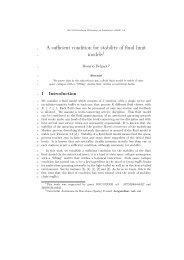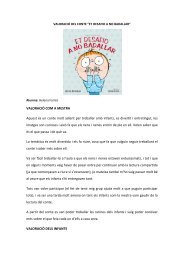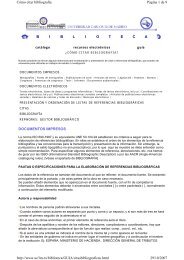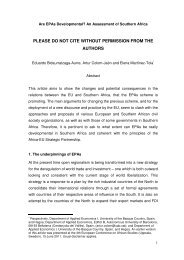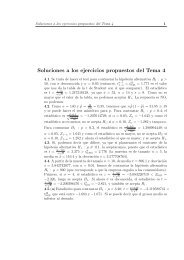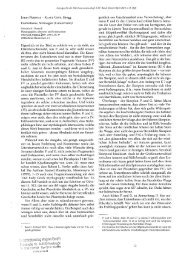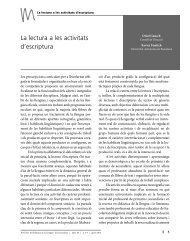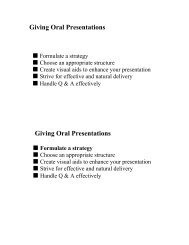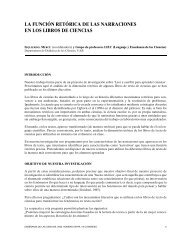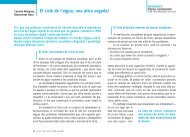J. Theor. Biol. 2006 - PÃ gines de la UAB
J. Theor. Biol. 2006 - PÃ gines de la UAB
J. Theor. Biol. 2006 - PÃ gines de la UAB
- No tags were found...
You also want an ePaper? Increase the reach of your titles
YUMPU automatically turns print PDFs into web optimized ePapers that Google loves.
ARTICLE IN PRESS<br />
Journal of <strong>Theor</strong>etical <strong>Biol</strong>ogy 239 (<strong>2006</strong>) 247–256<br />
www.elsevier.com/locate/yjtbi<br />
Coexistence and error propagation in pre-biotic vesicle mo<strong>de</strong>ls:<br />
A group selection approach<br />
Jose´ F. Fontanari a, , Mauro Santos b,c ,Eo¨rs Szathma´ry c,d<br />
a Instituto <strong>de</strong> Física <strong>de</strong> São Carlos, Universida<strong>de</strong> <strong>de</strong> São Paulo, Caixa Postal 369, 13560-970 São Carlos SP, Brazil<br />
b Department <strong>de</strong> Genètica i <strong>de</strong> Microbiologia, Universitat Autònoma <strong>de</strong> Barcelona, 08193 Bel<strong>la</strong>terra, Barcelona, Spain<br />
c Collegium Budapest, Institute for Advanced Study, Szentháromság u. 2, H-1014 Budapest, Hungary<br />
d Department of P<strong>la</strong>nt Taxonomy and Ecology, Eötvös University, 2 Ludovika tér, H-1083 Budapest, Hungary<br />
Received 26 April 2005; received in revised form 29 June 2005; accepted 23 July 2005<br />
Avai<strong>la</strong>ble online 21 October 2005<br />
Abstract<br />
Compartmentalization of unlinked, competing temp<strong>la</strong>tes is wi<strong>de</strong>ly accepted as a necessary step towards the evolution of complex<br />
organisms. However, preservation of information by temp<strong>la</strong>tes confined to iso<strong>la</strong>ted vesicles of finite size faces much har<strong>de</strong>r obstacles than<br />
by free temp<strong>la</strong>tes: random drift allied to mutation pressure wipe out any temp<strong>la</strong>te that does not replicate perfectly, no matter how small<br />
the error probability might be. In addition, drift alone hin<strong>de</strong>rs the coexistence of distinct temp<strong>la</strong>tes in a same compartment. Here, we<br />
investigate the conditions for group selection to prevail over drift and mutation and hence to guarantee the maintenance and coexistence<br />
of distinct temp<strong>la</strong>tes in a vesicle. Group selection is implemented through a vesicle survival probability that <strong>de</strong>pends on the temp<strong>la</strong>te<br />
composition. By consi<strong>de</strong>ring the limit case of an infinite number of vesicles, each one carrying a finite number of temp<strong>la</strong>tes, we were able<br />
to <strong>de</strong>rive a set of recursion equations for the frequencies of vesicles with different temp<strong>la</strong>te compositions. Numerical iteration of these<br />
recursions allows the exact characterization of the steady state of the vesicle popu<strong>la</strong>tion—a quasispecies of vesicles—thus revealing the<br />
values of the mutation and group selection intensities for which temp<strong>la</strong>te coexistence is possible. Within the main assumption of the<br />
mo<strong>de</strong>l—a fixed, finite or infinite, number of vesicles—we find no fundamental impediment to the coexistence of an arbitrary number of<br />
temp<strong>la</strong>te types with the same replication rate insi<strong>de</strong> a vesicle, except of course for the vesicle capacity. Group selection in the form of<br />
vesicle selection is a must for compartmentalized primordial genetic systems even in the absence of intra-genomic competition of different<br />
temp<strong>la</strong>tes.<br />
r 2005 Elsevier Ltd. All rights reserved.<br />
Keywords: Pre-biotic evolution; Group selection; Error threshold; Package mo<strong>de</strong>ls; Compartmentalization<br />
1. Introduction<br />
The apparently harmless observation that the length of a<br />
replicating polymer (i.e. RNA-like temp<strong>la</strong>te) is limited by<br />
the replication accuracy per nucleoti<strong>de</strong> has been a challenge<br />
to the <strong>de</strong>velopment of the field of pre-biotic evolution for<br />
more than three <strong>de</strong>ca<strong>de</strong>s (Eigen, 1971). Within the<br />
quasispecies framework, which may be used as a paradigm<br />
in this discussion, temp<strong>la</strong>tes have to replicate with high<br />
accuracy in or<strong>de</strong>r to reach a certain length, a requirement<br />
Corresponding author.<br />
E-mail addresses: fontanari@ifsc.usp.br (J.F. Fontanari), mauro.<br />
santos@uab.es (M. Santos), szathmary@colbud.hu (E. Szathmáry).<br />
that seems very unlikely to be met without the aid of<br />
specialized catalysts (pepti<strong>de</strong> enzymes). To build those<br />
catalysts, however, a blueprint is nee<strong>de</strong>d that amounts to a<br />
<strong>la</strong>rge nucleoti<strong>de</strong> sequence, which itself cannot be maintained<br />
without the catalysts. This is the so-called Catch-22<br />
of the origin of life: no <strong>la</strong>rge genome without enzymes, and<br />
no enzymes without a <strong>la</strong>rge genome (Maynard Smith,<br />
1983). The information crisis in pre-biotic evolution<br />
originates from this observation together with the finding<br />
that, except in a trivially <strong>de</strong>generate case, two or more<br />
temp<strong>la</strong>tes which differ significantly from each other cannot<br />
coexist (Swetina and Schuster, 1982). These two simple<br />
results have struck a fatal blow on the simplistic view of the<br />
emergence of a complex genome from a collection of<br />
0022-5193/$ - see front matter r 2005 Elsevier Ltd. All rights reserved.<br />
doi:10.1016/j.jtbi.2005.08.039
248<br />
ARTICLE IN PRESS<br />
J.F. Fontanari et al. / Journal of <strong>Theor</strong>etical <strong>Biol</strong>ogy 239 (<strong>2006</strong>) 247–256<br />
competing temp<strong>la</strong>tes: additional assumptions regarding<br />
cooperation between temp<strong>la</strong>tes are mandatory to overcome<br />
this impasse.<br />
Most proposals to circumvent the information crisis<br />
have conformed to the limitation of information co<strong>de</strong>d by<br />
a single temp<strong>la</strong>te, focusing instead on the conditions that<br />
guarantee the stable coexistence of different temp<strong>la</strong>tes (for<br />
rare exceptions, see Scheuring, 2000; Szabo´ et al., 2002).<br />
Since the total information content is the product of the<br />
number of different temp<strong>la</strong>tes and the maximum information<br />
co<strong>de</strong>d per temp<strong>la</strong>te, provi<strong>de</strong>d the temp<strong>la</strong>te types have<br />
the same concentration, ensuring the coexistence of<br />
different temp<strong>la</strong>tes resolves the information crisis. In this<br />
vein, Eigen (1971) and Eigen and Schuster (1979) proposed<br />
the hypercycle, i.e. a catalytic feedback network in which<br />
each temp<strong>la</strong>te helps in the replication of the next one, in a<br />
secondary cycle closing on itself (second-or<strong>de</strong>r autocatalysis).<br />
Originally, the enzymatic function (i.e. replicase<br />
activity) was thought to be carried out by the enco<strong>de</strong>d<br />
proteins (the ‘‘realistic’’ hypercycle: Eigen and Schuster,<br />
1979), but recently also the hypercycle is projected into the<br />
RNA world (Gilbert, 1986), with RNA molecules acting as<br />
temp<strong>la</strong>tes as well as enzymes (cf. Zintzaras et al., 2002).<br />
This view gained p<strong>la</strong>usibility when the ability of polynucleoti<strong>de</strong>s<br />
to exert various catalytic (enzymatic) functions<br />
was discovered (see Doudna and Szostak, 1989; Doudna<br />
and Lorsch, 2005 for review). However, if the number of<br />
hypercycle members is greater than four, the temp<strong>la</strong>te<br />
concentrations will vary with time (Eigen and Schuster,<br />
1979), periodically <strong>de</strong>creasing to very small values, thus<br />
making <strong>la</strong>rge hypercycles vulnerable to extinction via<br />
fluctuations (Nun˜o and Tarazona, 1994). The information<br />
gain due to the coexistence of different temp<strong>la</strong>tes in the<br />
hypercycle is then not significant. In addition, the hypercycles<br />
have attracted criticisms for other reason: as first<br />
pointed out by Maynard Smith (1979), giving catalytic<br />
support in such molecu<strong>la</strong>r networks is in fact an altruistic<br />
behaviour and so hypercycles are easy targets to parasites,<br />
i.e. molecules that do not reciprocate the catalytic support<br />
they receive. To solve the conundrum of dynamic coexistence<br />
of different temp<strong>la</strong>tes Szathma´ry and Demeter<br />
(1987), e<strong>la</strong>borating on the package mo<strong>de</strong>l proposed by<br />
Niesert et al. (1981), <strong>de</strong>scribed the ‘‘stochastic corrector<br />
mo<strong>de</strong>l’’ as an effective treatment against parasites and of<br />
the conflict among genes due to internal competition;<br />
namely, the compartmentalization or packaging of unlinked<br />
temp<strong>la</strong>tes that are replicated by genes with a nonspecific<br />
replicase functionality in iso<strong>la</strong>ted vesicles that<br />
reproduce by clonal selection (see also Grey et al., 1995), so<br />
that infected vesicles simply die out preventing the<br />
spreading of the mutant parasites to the healthy ones<br />
(but see Santos et al., 2003).<br />
Since the interaction of temp<strong>la</strong>tes within vesicles is<br />
essentially competitive and the vesicle dynamics, usually<br />
fission, would eventually lead to the loss of essential genes<br />
for survivorship (i.e. the assortment load), some sort of<br />
selection at the vesicle or compartment level is obviously<br />
required for these mo<strong>de</strong>ls as an alternative to hypercycles<br />
(see, e.g. Niesert et al., 1981; Szathma´ry and Demeter,<br />
1987; Alves et al., 2001; Zintzaras et al., 2002; Hogeweg<br />
and Takeuchi, 2003). However, although the coexistence of<br />
a few distinct temp<strong>la</strong>tes has been <strong>de</strong>monstrated for sure, a<br />
common criticism is that the package mo<strong>de</strong>l is a very<br />
sloppy system of information integration because the<br />
major difficulty for conserving a complete set of genes is<br />
the growth difference between replicators (e.g. Suzuki and<br />
Ono, 2003). Thus, in the mo<strong>de</strong>l of Niesert et al. (1981), the<br />
number of different temp<strong>la</strong>tes per compartment cannot<br />
exceed three given a realistic parameter setting. Therefore,<br />
although conceptually simpler than the hypercycles it is not<br />
clear whether the information content of the package<br />
mo<strong>de</strong>ls could be substantially <strong>la</strong>rger than the information<br />
content in the free-temp<strong>la</strong>te case. Simi<strong>la</strong>r to the package<br />
mo<strong>de</strong>l of Niesert et al. (1981) and the stochastic corrector<br />
mo<strong>de</strong>l (Szathma´ry and Demeter, 1987) we assume here that<br />
the temp<strong>la</strong>tes are replicated by a non-specific replicase.<br />
How this replicase evolved is a serious problem we leave<br />
open as there is no currently known metabolic path to<br />
RNA in pre-biotic settings, and the attainment of a fully<br />
functional RNA replicase is a very difficult enterprise<br />
(Johnston et al., 2001). Also, we do not know how many<br />
different temp<strong>la</strong>tes (genes) can coexist in the packages.<br />
In comparison with the hypercycle, very little is known<br />
about the dynamics and steady states of package mo<strong>de</strong>ls,<br />
since their greater complexity frustrates any attempt to<br />
carry out a thorough analysis of the space of parameters<br />
that <strong>de</strong>termine the evolution of temp<strong>la</strong>tes and vesicles. To<br />
bypass this difficulty, here we study a package/compartment<br />
mo<strong>de</strong>l using the discrete-time mathematical formalism<br />
of group selection (Eshel, 1972; Levin and Kilmer,<br />
1974; Aoki, 1982; Silva and Fontanari, 1999) in which a<br />
countable infinity of groups (vesicles, in the case) are<br />
iso<strong>la</strong>ted from each other (see, e.g. Wa<strong>de</strong>, 1978; Boorman<br />
and Levitt, 1980 for reviews). The total number of<br />
temp<strong>la</strong>tes confined in a vesicle is finite and is the same<br />
for all vesicles. Because of random genetic drift, this feature<br />
implies that in the absence of group selection (differential<br />
extinction <strong>de</strong>pending on the internal temp<strong>la</strong>te composition<br />
of the group) only one type of temp<strong>la</strong>te will be present in a<br />
given vesicle in the equilibrium regime. Of course, the<br />
surviving temp<strong>la</strong>te type may not be the same in different<br />
vesicles. Hence, by barring the coexistence of distinct<br />
temp<strong>la</strong>tes in the same vesicle, random drift p<strong>la</strong>ys a simi<strong>la</strong>r<br />
role as the temp<strong>la</strong>te assortment procedure of the stochastic<br />
corrector mo<strong>de</strong>l. Here, a group is viewed as an iso<strong>la</strong>ted set<br />
of temp<strong>la</strong>tes that maintains its integrity during its entire<br />
existence. This view contrasts with the ephemeral groups of<br />
Wilson’s (1980) formu<strong>la</strong>tion wi<strong>de</strong>ly used in pre-biotic<br />
evolution (Michod, 1983; Donato et al., 1997; Alves<br />
et al., 2001) and viral dynamics (Szathma´ry, 1992) in<br />
which the group structure is dissolved each generation to<br />
form a global mating pool; but comes close to the<br />
stochastic corrector mo<strong>de</strong>l. In particu<strong>la</strong>r, in the transient<br />
‘‘group’’ formu<strong>la</strong>tion random drift p<strong>la</strong>ys no role at all,
ARTICLE IN PRESS<br />
J.F. Fontanari et al. / Journal of <strong>Theor</strong>etical <strong>Biol</strong>ogy 239 (<strong>2006</strong>) 247–256 249<br />
since different temp<strong>la</strong>tes in distinct vesicles are likely to be<br />
assigned to the same vesicle during the group re-assembling<br />
procedure after the mating stage. Our approach allows us<br />
to <strong>de</strong>rive exact recursion equations for the frequency of<br />
vesicles with a given temp<strong>la</strong>te composition, which are then<br />
easily solved numerically.<br />
In addition to establishing the conditions that must be<br />
met to guarantee the coexistence of a given number of<br />
temp<strong>la</strong>tes insi<strong>de</strong> a vesicle, in this contribution we consi<strong>de</strong>r<br />
explicitly the existence of a special c<strong>la</strong>ss of temp<strong>la</strong>tes, socalled<br />
error-tail, that appears as a consequence of the<br />
replication errors of the original temp<strong>la</strong>tes and has no<br />
effect whatsoever on the survival of the vesicle. Backmutations<br />
and mutations between the original c<strong>la</strong>sses of<br />
temp<strong>la</strong>tes are neglected. This simplified formu<strong>la</strong>tion<br />
facilitated greatly the analysis of the error threshold in<br />
Eigen’s mo<strong>de</strong>l (Maynard Smith, 1983; Scheuring, 2000) as<br />
well as in the hypercycle (Garcı´a-Tejedor et al., 1987; Nun˜o<br />
et al., 1993; Campos et al., 2000). An interesting <strong>de</strong>tailed<br />
study of the influence of vesicle dynamics on the information<br />
threshold in the case when vesicles are occupied by a<br />
single uncorrupted temp<strong>la</strong>te type and its error tail is given<br />
by Hogeweg and Takeuchi (2003) in the context of a<br />
cellu<strong>la</strong>r automaton mo<strong>de</strong>l, both at the level of temp<strong>la</strong>tes<br />
and vesicles.<br />
2. The mo<strong>de</strong>l<br />
The popu<strong>la</strong>tion is composed of an infinite number of<br />
vesicles, each of which encloses exactly N temp<strong>la</strong>tes. There<br />
are d þ 1 distinct types of temp<strong>la</strong>tes, <strong>la</strong>belled by the<br />
integers l ¼ 0; 1; ...; d, where type l ¼ 0 <strong>de</strong>notes temp<strong>la</strong>tes<br />
belonging to the error tail. The temp<strong>la</strong>tes replication rates<br />
are <strong>de</strong>noted by s 0 ; s 1 ; ...; s d with s 1 4s 2 4 4s d 4s 0<br />
without loss of generality. Due to imperfect replication,<br />
temp<strong>la</strong>tes of type l40 mutate to temp<strong>la</strong>tes of type l ¼ 0<br />
(error tail) with probability u. Back-mutations and mutations<br />
between uncorrupted temp<strong>la</strong>tes are neglected. The<br />
vesicles are i<strong>de</strong>ntified according to their temp<strong>la</strong>te composition<br />
by the vector k ~ ¼ðk 0 ; k 1 ; ...; k d Þ, where the component<br />
k l stands for the number of temp<strong>la</strong>tes of type l in the<br />
vesicle. Since P <br />
d<br />
l¼0 k d þ N<br />
l ¼ N, there are<br />
different<br />
N<br />
types of vesicles. The state of the popu<strong>la</strong>tion at a given<br />
generation t is completely specified by the frequencies of<br />
vesicles of type k, ~ which we <strong>de</strong>note by Y t ð kÞ ~ with<br />
P<br />
~k Y tð kÞ¼1 ~ for all t. The life cycle (i.e. one generation)<br />
consists of four events—extinction, recolonization, replication<br />
and mutation—which take p<strong>la</strong>ce in this or<strong>de</strong>r and are<br />
<strong>de</strong>scribed as follows.<br />
2.1. Extinction<br />
The basic i<strong>de</strong>a of addressing the information crisis<br />
problem by ensuring the coexistence of distinct temp<strong>la</strong>tes is<br />
that the information content of a vesicle is split into d parts<br />
and all of them must be present at all times to guarantee<br />
the viability of the system. In addition, it is <strong>de</strong>sirable that<br />
the different temp<strong>la</strong>tes contribute with approximately the<br />
same number to the vesicle composition. Hence, we <strong>de</strong>fine<br />
the probability<br />
<br />
that a vesicle of type k ~ survives extinction,<br />
<strong>de</strong>noted by a k ~ <br />
2 ½0; 1Š, as a function proportional to the<br />
geometric mean of the number of temp<strong>la</strong>tes confined in the<br />
vesicle:<br />
að ~ kÞ¼1 g þ g d N ðk 1k 2 ...k d Þ 1=d , (1)<br />
where g 2 ½0; 1Š is a parameter measuring the intensity of<br />
the group selection pressure or the benefit accrued to the<br />
vesicle from the presence of the temp<strong>la</strong>tes within it.<br />
Survival is guaranteed (i.e. a ¼ 1) only for vesicles which<br />
have the even temp<strong>la</strong>te composition k l ¼ N=d for l ¼<br />
1; ...; d regardless of the value of g, provi<strong>de</strong>d this value is<br />
not zero. Vesicles that <strong>la</strong>ck one or more temp<strong>la</strong>te types are<br />
assigned the baseline survival probability 1 g, so that the<br />
selective pressure against these vesicles increases with<br />
increasing the value of g. In this sense, this formu<strong>la</strong>tion is<br />
akin to that of the single sharp-peak replication <strong>la</strong>ndscape<br />
of the quasispecies mo<strong>de</strong>l (Eigen, 1971). The geometric<br />
mean that appears in Eq. (1) has been repeatedly used to<br />
mo<strong>de</strong>l the metabolic function associated in recent mo<strong>de</strong>ls<br />
of replicator networks (e.g. Cza´ra´n and Szathma´ry, 2000).<br />
The baseline survival probability 1 g, however, is a new<br />
ingredient of our mo<strong>de</strong>l that takes into account the<br />
experimental finding that vesicles actually grow and divi<strong>de</strong><br />
even in the absence of temp<strong>la</strong>tes (Hanczyc et al., 2003). We<br />
note that whenever a mutation occurs a useful temp<strong>la</strong>te,<br />
say, temp<strong>la</strong>te 1 is rep<strong>la</strong>ced by an inert temp<strong>la</strong>te of the errortail<br />
c<strong>la</strong>ss, k 1 <strong>de</strong>creases and so does the survival probability<br />
of the vesicle, since the numbers of the other uncorrupted<br />
temp<strong>la</strong>te k 2 ; ...; k d are unaltered. Hence, mutations have a<br />
direct <strong>de</strong>leterious effect on the protocell replication rate.<br />
2.2. Recolonization<br />
P<br />
As the result of extinction, a fraction 1 ~k Y tð kÞ ~ of<br />
vesicles disappears and is then rep<strong>la</strong>ced or recolonized by<br />
the surviving vesicles. This is done by reproducing these<br />
vesicles in proportion to their frequencies in the popu<strong>la</strong>tion,<br />
resulting in the following new vesicle frequencies:<br />
að kÞY ~ t ð kÞ ~ P<br />
~j að (2)<br />
~jÞY t ð~jÞ<br />
from which it becomes clear that the recolonization<br />
procedure introduces an effective competition between<br />
the vesicles. In fact, Eq. (2) prompts the interpretation of<br />
the parameter að kÞ ~ as the replication rate of a vesicle of<br />
composition k ~ ¼ k 0 ; ...; k d . We note, however, that the<br />
procedure used here for recolonization (Eshel, 1972; Levin<br />
and Kilmer, 1974; Aoki, 1982; Silva and Fontanari, 1999)<br />
implies the instantaneous rep<strong>la</strong>cement of the extinct<br />
vesicles by the surviving ones with the probability given
250<br />
ARTICLE IN PRESS<br />
J.F. Fontanari et al. / Journal of <strong>Theor</strong>etical <strong>Biol</strong>ogy 239 (<strong>2006</strong>) 247–256<br />
in Eq. (2). For example, in an extreme situation, in which<br />
only one vesicle passes the extinction stage, this sole vesicle<br />
will replenish the entire popu<strong>la</strong>tion (infinite or finite) in a<br />
single time step. In any event, provi<strong>de</strong>d that g does not<br />
equal 1, we can safely ignore this difficulty.<br />
2.3. Replication<br />
This process <strong>de</strong>scribes the replication of the temp<strong>la</strong>tes<br />
insi<strong>de</strong> the vesicles. As usual, we assume that the number of<br />
offspring that a temp<strong>la</strong>te contributes to the new generation<br />
is proportional to its re<strong>la</strong>tive replication rate. Since only N<br />
offspring are chosen to rep<strong>la</strong>ce the N parents we can write<br />
the probability that a vesicle of type ~ k changes to a vesicle<br />
of type ~j as<br />
Rð~jj kÞ¼ ~ N!<br />
j 0 !j 1 !...j d ! wj 0<br />
0<br />
w j 1<br />
1<br />
...w j d<br />
d<br />
, (3)<br />
where w l ¼ k l s l =w for l ¼ 0; 1; ...; d are the re<strong>la</strong>tive<br />
replication rates of the temp<strong>la</strong>te types. Here, w ¼ k 0 s 0 þ<br />
k 1 s 1 þþk d s d is the average replication rate of the entire<br />
popu<strong>la</strong>tion.<br />
2.3.1. Mutation<br />
The effect of the mutation process is solely to increase<br />
the number of temp<strong>la</strong>tes in the error tail. Hence, the<br />
probability that a vesicle of type ~j changes to one of type ~i<br />
is simply<br />
Mð~ij~jÞ ¼ j !<br />
1<br />
u j 1 i 1<br />
ð1 uÞ i 1<br />
...<br />
i 1<br />
!<br />
j d<br />
u j d i d<br />
ð1 uÞ i d<br />
(4)<br />
i d<br />
with j l 4i l for l ¼ 1; ...; d and j 0 pi 0 .<br />
The processes of temp<strong>la</strong>te replication and mutation can<br />
be <strong>de</strong>scribed by a single transition matrix Tð~ij kÞ¼<br />
P<br />
~ ~j Mð ~ij~jÞRð~jj kÞ, ~ that gives the probability that a vesicle of<br />
type k ~ changes to a vesicle of type ~i, due to replication<br />
immediately followed by mutation of the offspring. In fact,<br />
the present approach is feasible only because we can carry<br />
out the sum over the intermediate states ~j and <strong>de</strong>rive a<br />
closed expression for this combined transition matrix. We<br />
find<br />
Tð~ij kÞ¼ ~ N!<br />
i 0 !i 1 !...i d ! ½u þ w 0ð1 uÞŠ i 0<br />
½w 1 ð1 uÞŠ i 1<br />
...½w d ð1 uÞŠ i d<br />
; ð5Þ<br />
where w l are the re<strong>la</strong>tive replication rates given before.<br />
Finally, given the events comprising the life cycle of the<br />
temp<strong>la</strong>tes and vesicles we can immediately write down a set<br />
of coupled recursion equations for the frequencies of the<br />
different types of vesicles in the popu<strong>la</strong>tion:<br />
P<br />
Y tþ1 ð~iÞ ¼<br />
~k Tð ~ij kÞað ~ kÞY ~ t ð kÞ ~<br />
P<br />
~k að~ kÞY t ð kÞ ~ . (6)<br />
The main difficulty to iterate numerically these equations is<br />
that one has to keep track of the or<strong>de</strong>r of N d frequencies at<br />
each generation, thus setting limits to the vesicle capacity N<br />
and the temp<strong>la</strong>te diversity d we can investigate. All results<br />
presented in this paper are obtained in the stationary<br />
regime Y tþ1 ¼ Y t ¼ Y. We found these steady states<br />
remarkably insensitive to the choice of the initial distribution<br />
of temp<strong>la</strong>tes in the vesicles Y t¼0 ð kÞ: ~ provi<strong>de</strong>d that<br />
there are vesicles that contain all uncorrupted temp<strong>la</strong>te<br />
types, the dynamics will always approach the same steady<br />
state. In what follows, we will focus mainly on the fraction<br />
O m of vesicles that carry copies of mpd uncorrupted<br />
temp<strong>la</strong>te types, regardless of their redundancy.<br />
3. Coexistence of error-free temp<strong>la</strong>tes<br />
Before consi<strong>de</strong>ring the effect of imperfect replication and<br />
the consequent appearance of the error tail, in this section<br />
we focus on the somewhat simpler though fundamental<br />
problem of the coexistence of temp<strong>la</strong>tes with distinct<br />
replication rates. By setting u ¼ 0 and Y t¼0 ð ~ kÞ¼0, if<br />
k 0 a0, our mathematical formalism can be readily used to<br />
study this problem as well. As already pointed out, random<br />
drift will bar the coexistence of two or more distinct<br />
temp<strong>la</strong>tes in a vesicle of finite capacity. On the other si<strong>de</strong>,<br />
competition between temp<strong>la</strong>tes will lead to the dominance<br />
of the temp<strong>la</strong>te with the highest replication rate in the case<br />
of very <strong>la</strong>rge vesicles. Here, we address the issue of how<br />
strong the group selection pressure must be in or<strong>de</strong>r to<br />
counterba<strong>la</strong>nce the effects of drift and competition.<br />
Fig. 1, which disp<strong>la</strong>ys the fraction O 2 as a function of the<br />
group selection intensity g for d ¼ 2, N ¼ 50 and several<br />
values of the ratio s 2 =s 1 , reveals the existence of a threshold<br />
value for g, below which random drift and temp<strong>la</strong>te<br />
competition are the dominant forces, resulting then in the<br />
complete frustration of temp<strong>la</strong>te coexistence. To gauge and<br />
even disentangle the contributions of drift and competition<br />
we can vary the vesicle capacity N. This is illustrated in<br />
Ω 2<br />
1<br />
0.8<br />
0.6<br />
0.4<br />
0.2<br />
1.0<br />
0.75<br />
0<br />
0 0.2 0.4 0.6 0.8 1<br />
g<br />
0.5<br />
0.25<br />
Fig. 1. Fraction of vesicles with the two different types of temp<strong>la</strong>tes in<br />
their composition O 2 as a function of the group selection pressure g for<br />
N ¼ 50, s 2 =s 1 ¼ 1:0; 0:75; 0:5 and 0.25 in the case of error-free replication<br />
u ¼ 0.
ARTICLE IN PRESS<br />
J.F. Fontanari et al. / Journal of <strong>Theor</strong>etical <strong>Biol</strong>ogy 239 (<strong>2006</strong>) 247–256 251<br />
1<br />
1<br />
0.8<br />
0.25<br />
0.8<br />
0.6<br />
0.5<br />
0.6<br />
2 3 4<br />
g c<br />
0.4<br />
0.2<br />
0.75<br />
0<br />
0 20 40 60 80 100<br />
N<br />
Fig. 2. Critical value of the group selection pressure g c as a function of the<br />
vesicle capacity N for d ¼ 2, s 2 =s 1 ¼ 1:0; 0:75; 0:5 and 0.25 in the case of<br />
error-free replication u ¼ 0. Coexistence of the two temp<strong>la</strong>te types in a<br />
same vesicle is guaranteed above g c . The line for s 2 =s 1 ¼ 1:0 is the fitting<br />
g c ¼ 1=N, the other lines are gui<strong>de</strong>s to eye.<br />
1.0<br />
Ω d<br />
0.4<br />
0.2<br />
2 3 4<br />
0<br />
0 0.2 0.4 0.6 0.8 1<br />
g<br />
Fig. 3. Fraction of vesicles with d ¼ 2; 3 and 4 different types of temp<strong>la</strong>tes<br />
in their composition O d as a function of the group selection pressure g for<br />
N ¼ 24 in the case of error-free replication u ¼ 0. The solid lines are the<br />
results for <strong>de</strong>generate replication rates and the dashed lines are the results<br />
for s 2 =s 1 ¼ 0:8 (d ¼ 2); s 2 =s 1 ¼ 0:8, s 3 =s 1 ¼ 0:6 (d ¼ 3); and s 2 =s 1 ¼ 0:8,<br />
s 3 =s 1 ¼ 0:6, s 4 =s 1 ¼ 0:4 (d ¼ 4).<br />
Fig. 2 which shows the <strong>de</strong>pen<strong>de</strong>nce of the threshold value<br />
g c , below which coexistence is impossible, on the vesicle<br />
capacity N. In the absence of competition (s 2 =s 1 ¼ 1),<br />
coexistence is facilitated by increasing the vesicle capacity<br />
since this attenuates the effect of drift. The data for this<br />
case (lower curve in Fig. 2) are fitted perfectly by the<br />
function g c ¼ 1=N. The situation is more complicated<br />
when competition (s 2 =s 1 o1) is taken into account: after an<br />
initial <strong>de</strong>crease, due to reduction of drift, g c starts to<br />
increase smoothly towards the singu<strong>la</strong>r value g c ¼ 1 as the<br />
vesicle size grows and consequently temp<strong>la</strong>te competition is<br />
enhanced. As has already been said, our formu<strong>la</strong>tion<br />
breaks down if the group selection pressure is set to its<br />
maximum value, since a singu<strong>la</strong>r situation in which all<br />
vesicles are extinct at the same time (i.e. a i ¼ 0 for all i such<br />
that Y i a0) is likely to arise. In fact, this is exactly what<br />
happens in the <strong>de</strong>terministic regime (N !1). Since the<br />
random fluctuations that promote the diversity of the<br />
vesicles are suppressed in this regime, the vesicles soon<br />
become all alike and so group selection is turned off.<br />
Temp<strong>la</strong>te competition is then free to act ending in the<br />
fixation of the fitter temp<strong>la</strong>te in all vesicles regardless of the<br />
value of go1. Note that the singu<strong>la</strong>rity, i.e. the simultaneous<br />
vanishing of the numerator and <strong>de</strong>nominator in<br />
Eq. (6), occurs at g ¼ 1 only. Hence, except for the<br />
<strong>de</strong>generate case s 2 =s 1 ¼ 1, temp<strong>la</strong>te coexistence is impossible<br />
in the <strong>de</strong>terministic regime.<br />
The rich tra<strong>de</strong>-off between drift and competition is<br />
responsible for the appearance of a minimum in the curves<br />
g c vs. N. This minimum disappears for small values of the<br />
ratio s 2 =s 1 indicating that the effect of drift becomes<br />
negligible compared to that of competition. However, in<br />
the probably more realistic case that the temp<strong>la</strong>te replication<br />
rates are almost <strong>de</strong>generate (s 2 =s 1 1), it is the effect<br />
of temp<strong>la</strong>te competition that is negligible, provi<strong>de</strong>d the<br />
vesicle capacity is not too <strong>la</strong>rge. Fig. 3 illustrates the<br />
<strong>de</strong>pen<strong>de</strong>nce of O d on g for a vesicle of fixed size N ¼ 24 and<br />
d ¼ 2; 3 and 4 different temp<strong>la</strong>te types in the <strong>de</strong>generate<br />
case (i.e. s 1 ¼ s s ¼¼s d ) as well as in the more general<br />
situation that all replication rates are different. Regardless<br />
of whether competition is allowed or not, coexistence of<br />
many distinct temp<strong>la</strong>tes can be achieved by increasing the<br />
group selection pressure, though as mentioned before, care<br />
must be taken to avoid the singu<strong>la</strong>r value g ¼ 1. In fact, we<br />
found no evi<strong>de</strong>nce of a threshold on the number of<br />
temp<strong>la</strong>tes beyond which coexistence is preclu<strong>de</strong>d. For<br />
instance, in the extreme case of d ¼ N <strong>de</strong>generate<br />
temp<strong>la</strong>tes, the recursion equations (6) can be solved<br />
analytically, resulting in the simple expression:<br />
O d¼N ¼ 1 <br />
g g 1 d!<br />
d d<br />
<br />
<br />
, (7)<br />
valid for gX1 d! d d . We note that in this region, O d¼N is<br />
a very small quantity, on the or<strong>de</strong>r of expð dÞ for <strong>la</strong>rge d.<br />
So there is no fundamental impediment to the coexistence<br />
of an arbitrary number dpN of distinct temp<strong>la</strong>tes in a<br />
vesicle of capacity N, provi<strong>de</strong>d that the group selection<br />
parameter can be set arbitrarily close, but not equal, to 1.<br />
Of course, as g approaches 1 the fraction of vesicles that<br />
contain all temp<strong>la</strong>te types <strong>de</strong>creases very rapidly and so the<br />
vast majority of the vesicles present in the popu<strong>la</strong>tion will<br />
<strong>la</strong>ck one or more types. Hence, group selection alone<br />
cannot exp<strong>la</strong>in the prevalence of that ‘‘cooperative’’ kind<br />
of vesicle and so one needs to invoke another mechanism to<br />
suppress temp<strong>la</strong>te competition, which will then permit the<br />
rare representatives of the cooperative vesicles (we have<br />
proven that group selection can maintain a few vesicles of<br />
that kind) to take over the vesicle popu<strong>la</strong>tion. The<br />
ingredient missing is probably a selective pressure for
252<br />
ARTICLE IN PRESS<br />
J.F. Fontanari et al. / Journal of <strong>Theor</strong>etical <strong>Biol</strong>ogy 239 (<strong>2006</strong>) 247–256<br />
linkage of all temp<strong>la</strong>tes on a single chromosome (Maynard<br />
Smith and Szathma´ry, 1993; Santos, 1998). In that sense,<br />
the (partial) failure of group selection is welcome,<br />
otherwise it would be difficult to exp<strong>la</strong>in gene linkage,<br />
and hence the origin of chromosomes, if an arbitrary<br />
number of unlinked temp<strong>la</strong>tes could easily be ma<strong>de</strong> to<br />
coexist within compartments.<br />
To verify how our conclusions are affected by the<br />
assumption that there are a countable infinity of vesicles,<br />
here we carry out a simple Monte-Carlo simu<strong>la</strong>tion to<br />
study the situation in which the number of vesicle is fixed to<br />
a finite value M. Explicitly, we re-interpret Eq. (2) as the<br />
re<strong>la</strong>tive fitness of vesicles composed of k 1 ; k 2 ; ...; k d<br />
temp<strong>la</strong>te types and then use a transition probability<br />
analogous to Eq. (3) to generate the new vesicle popu<strong>la</strong>tion<br />
from the previous one. Essentially, the same stochastic<br />
procedure used to mo<strong>de</strong>l the temp<strong>la</strong>te replication insi<strong>de</strong><br />
each vesicle is used to mo<strong>de</strong>l vesicle replication. The results<br />
for d ¼ 2 <strong>de</strong>generate (s 2 =s 1 ¼ 1) temp<strong>la</strong>tes fenced in M ¼<br />
10; 20 and 40 vesicles of capacity N ¼ 20 are <strong>de</strong>picted in<br />
Fig. 4 together with the analytical result for M !1. The<br />
data represent averages over 100 in<strong>de</strong>pen<strong>de</strong>nt runs. The<br />
point to be noted here is that the behaviour pattern<br />
observed in the case of a finite number of vesicles does not<br />
differ qualitatively from the pattern predicted by the<br />
<strong>de</strong>terministic theory: the sole effect of finite M is to<br />
increase the value of the threshold g c so as to make<br />
coexistence more difficult. As expected, the agreement<br />
between our analytical results and the Monte-Carlo<br />
simu<strong>la</strong>tions improves as M increases and, in particu<strong>la</strong>r,<br />
they become practically indistinguishable for M4500.<br />
Note, however, that by fixing the number of vesicles we<br />
have ruled out the possibility of extinction of the vesicle<br />
popu<strong>la</strong>tion, a realistic ingredient that might pose a serious<br />
obstacle to temp<strong>la</strong>te coexistence when g is set too close to 1.<br />
Nevertheless, our results apply provi<strong>de</strong>d the vesicle<br />
popu<strong>la</strong>tion is not extinct, since then it is likely to be very<br />
<strong>la</strong>rge.<br />
4. The effect of the error tail<br />
The consequences of imperfect replication are catastrophic<br />
for temp<strong>la</strong>tes iso<strong>la</strong>ted in compartments of finite<br />
capacity: even for a vanishing small mutation probability<br />
(u 0) and replication rate (s 0 =s l 0; l ¼ 1; ...; d), the<br />
error tail will be fixed in the compartment. In fact, though<br />
rare, mutations are recurrent and so they will prevent the<br />
fixation of the uncorrupted temp<strong>la</strong>tes. In addition, the<br />
fixation of the error trail is very unlikely to occur because<br />
of its small replication rate, but once it does the game is<br />
over for the uncorrupted temp<strong>la</strong>tes. A possible way out of<br />
this conundrum is to invoke again group selection—the<br />
selection at the vesicle level. The pressing question of how<br />
strong group selection must be in or<strong>de</strong>r to ensure the<br />
survival of temp<strong>la</strong>tes confined in a vesicle is addressed in<br />
this section, where we will concentrate on the interp<strong>la</strong>y<br />
between the group selection pressure and the mutation<br />
probability in the case of d ¼ 1 and 2 temp<strong>la</strong>tes. Since in<br />
the previous section we have shown that introducing<br />
competition between temp<strong>la</strong>tes does not alter qualitatively<br />
the behaviour pattern observed in the case of <strong>de</strong>generate<br />
temp<strong>la</strong>tes, henceforth we will consi<strong>de</strong>r the situation in<br />
which all d uncorrupted temp<strong>la</strong>tes have the same replication<br />
rate, which we set to 1 without loss of generality, while<br />
temp<strong>la</strong>tes in the error tail have replication rate 1 t with<br />
t 2 ½0; 1Š.<br />
First we consi<strong>de</strong>r the case of a single uncorrupted<br />
temp<strong>la</strong>te type (d ¼ 1) in a vesicle of capacity N. Error-tail<br />
temp<strong>la</strong>tes are not inclu<strong>de</strong>d in the initial assignment of<br />
temp<strong>la</strong>tes to vesicles. In Fig. 5, we show the steady-state<br />
frequencies of vesicles with several temp<strong>la</strong>te compositions.<br />
All these frequencies vanish at a critical value of the<br />
1<br />
0.2<br />
0.8<br />
0.15<br />
20<br />
0<br />
0.6<br />
16<br />
Ω 2<br />
0.4<br />
40<br />
20<br />
10<br />
Y<br />
0.1<br />
12<br />
8<br />
4<br />
0.2<br />
0.05<br />
0<br />
0 0.2 0.4 0.6 0.8 1<br />
g<br />
Fig. 4. Fraction of vesicles with two <strong>de</strong>generate types of temp<strong>la</strong>tes in their<br />
composition O 2 as a function of the group selection pressure g for M ¼<br />
10; 20 and 40 vesicles of fixed capacity N ¼ 20. The solid line is the<br />
analytical result for M !1.<br />
0<br />
0 0.05 0.1 0.15 0.2 0.25 0.3<br />
u<br />
Fig. 5. Steady-state frequencies of vesicles with i ¼ 0; 4; 8; 12; 16 and 20<br />
copies of the temp<strong>la</strong>te as a function of the mutation probability u for<br />
d ¼ 1, N ¼ 20, t ¼ 0:1 and g ¼ 0:5. We note that Yð20Þ !1 for u ! 0<br />
and Yð0Þ !1 for u ! u c 0:26.
ARTICLE IN PRESS<br />
J.F. Fontanari et al. / Journal of <strong>Theor</strong>etical <strong>Biol</strong>ogy 239 (<strong>2006</strong>) 247–256 253<br />
mutation probability u c 0:26, except for Yð0Þ that tends<br />
to 1, indicating that the error tail has become fixed in all<br />
vesicles. This figure endorses the portrait of package<br />
mo<strong>de</strong>ls in equilibrium as a quasispecies of compartments<br />
with internal competition, as <strong>de</strong>monstrated for the<br />
stochastic corrector mo<strong>de</strong>l (Szathma´ry and Demeter,<br />
1987) and, in addition, <strong>de</strong>monstrates the existence of an<br />
error threshold u c beyond which the uncorrupted temp<strong>la</strong>te<br />
is lost from the popu<strong>la</strong>tion. A better characterization of<br />
this threshold is given in Fig. 6 that shows the fraction of<br />
vesicles that contain at least one copy of the uncorrupted<br />
temp<strong>la</strong>te O 1 as a function of the mutation probability for<br />
several values of the group selection pressure. The point<br />
here is to emphasize that u c goes to zero when the group<br />
selection pressure is turned off, in agreement with the<br />
qualitative reasoning presented in the beginning of the<br />
section. The effect of changing the vesicle capacity N,<br />
<strong>de</strong>picted in Fig. 7, is quite complex and somewhat puzzling.<br />
For small u, increasing N favours the persistence of the<br />
uncorrupted temp<strong>la</strong>te as expected since the effect of drift is<br />
attenuated in this case. However, for <strong>la</strong>rge u the situation is<br />
reversed, resulting that low capacity vesicles become able to<br />
tolerate much higher mutation rates. The reason for that is<br />
as follows. According to Eq. (1), for <strong>la</strong>rge N the survival<br />
probability is significant only for those vesicles with a <strong>la</strong>rge<br />
number of temp<strong>la</strong>tes. Vesicles with few temp<strong>la</strong>tes have<br />
survival probability only slightly <strong>la</strong>rger (or<strong>de</strong>r of 1=N) than<br />
the baseline. Thus, by diminishing the number of uncorrupted<br />
temp<strong>la</strong>tes, <strong>la</strong>rge mutation rates will weaken the<br />
efficacy of group selection to maintain the temp<strong>la</strong>tes in<br />
<strong>la</strong>rge vesicles. We note that in the <strong>de</strong>terministic regime O 1<br />
becomes the step function O 1 ¼ 1 for uot and O 1 ¼ 0<br />
otherwise. These results are summarized in Fig. 8 where the<br />
critical mutation probability is presented against the group<br />
selection pressure. For g ¼ 0 we find u c ¼ 0 regardless of<br />
the values of t and N; however, this critical value jumps to<br />
a finite value for any arbitrarily small value of g for t not<br />
Ω 1<br />
1<br />
0.8<br />
0.6<br />
0.4<br />
0.2<br />
500<br />
100<br />
20<br />
0<br />
0 0.05 0.1 0.15 0.2 0.25 0.3 0.35 0.4 0.45<br />
u<br />
Fig. 7. Fraction of vesicles with at least one uncorrupted temp<strong>la</strong>te O 1 as a<br />
function of the mutation probability u for d ¼ 1, g ¼ 0:5, t ¼ 0:1 and<br />
N ¼ 2; 10; 20; 100 and 500.<br />
u c<br />
1<br />
0.8<br />
0.6<br />
0.4<br />
0.2<br />
0.9<br />
0.5<br />
0 0.2 0.4 0.6 0.8 1<br />
g<br />
Fig. 8. Critical value of the mutation probability u c above which the<br />
uncorrupted temp<strong>la</strong>te is lost as a function of the group selection pressure g<br />
for d ¼ 1, N ¼ 20 and t ¼ 0:1; 0:5 and 0.9.<br />
10<br />
0.1<br />
2<br />
Ω 1<br />
1<br />
0.8<br />
0.6<br />
0.4<br />
0.2<br />
0.1<br />
0.5<br />
0.8<br />
0.9<br />
0<br />
0 0.2 0.4 0.6 0.8 1<br />
u<br />
Fig. 6. Fraction of vesicles with at least one uncorrupted temp<strong>la</strong>te O 1 as a<br />
function of the mutation probability u for d ¼ 1, N ¼ 20, t ¼ 0:1 and<br />
g ¼ 0:1; 0:5; 0:8; 0:9 and 1.<br />
1<br />
too small. Although our numerical results cannot guarantee<br />
the existence of a real discontinuity at g ¼ 0, at least the<br />
extreme sensitivity of the threshold to a non-zero value of g<br />
is clearly <strong>de</strong>monstrated.<br />
We turn now to the analysis of the case of two<br />
uncorrupted temp<strong>la</strong>te types (d ¼ 2) confined in vesicles of<br />
finite capacity. As before, error-tail temp<strong>la</strong>tes are left out of<br />
the initial assignment of temp<strong>la</strong>tes to vesicles. Fig. 9<br />
illustrates the typical equilibrium behaviour pattern of the<br />
fraction of vesicles of capacity N ¼ 20 containing m ¼ 0; 1<br />
and 2 uncorrupted temp<strong>la</strong>te types (regardless of their<br />
numbers). The group selection pressure, set to g ¼ 0:5, can<br />
maintain the coexistence of the two temp<strong>la</strong>te types in more<br />
than 90% of the vesicles in the absence of replication<br />
errors, u ¼ 0. Initially, increasing the mutation probability<br />
(up to u ¼ 0:05) results in an increase of vesicles carrying<br />
only one type of uncorrupted temp<strong>la</strong>te (m ¼ 1) at the
254<br />
ARTICLE IN PRESS<br />
J.F. Fontanari et al. / Journal of <strong>Theor</strong>etical <strong>Biol</strong>ogy 239 (<strong>2006</strong>) 247–256<br />
Ω m<br />
1<br />
0.8<br />
0.6<br />
0.4<br />
0.2<br />
1<br />
0<br />
0 0.05 0.1 0.15 0.2<br />
u<br />
Fig. 9. Fraction of vesicles carrying m ¼ 0, 2 and 2 uncorrupted temp<strong>la</strong>te<br />
types as a function of the mutation probability for d ¼ 2, N ¼ 20, t ¼ 0:1<br />
and g ¼ 0:5.<br />
u c<br />
1<br />
0.8<br />
0.6<br />
0.4<br />
0.2<br />
expense of the vesicles carrying the two types (m ¼ 2).<br />
Vesicles carrying only error-tail temp<strong>la</strong>tes (m ¼ 0) become<br />
common for <strong>la</strong>rger values of the mutation probability. The<br />
fact that both fractions O 1 and O 2 vanish simultaneously at<br />
a single threshold value is easily un<strong>de</strong>rstood. According to<br />
Eq. (1), vesicles <strong>la</strong>cking one or more uncorrupted temp<strong>la</strong>te<br />
type are assigned the baseline survival probability, and so<br />
group selection is turned off when the vesicles with m ¼ d<br />
uncorrupted temp<strong>la</strong>te types are extinct. Since we have<br />
already argued that in the absence of group selection<br />
uncorrupted temp<strong>la</strong>tes cannot be maintained in vesicles of<br />
finite capacity, the vesicles with mod must die out too. In<br />
fact, the <strong>de</strong>pen<strong>de</strong>nce of the critical mutation probability on<br />
the group selection pressure, <strong>de</strong>picted in Fig. 10, reinforces<br />
this point (though for a rather low vesicle capacity N ¼ 6),<br />
since for go0:18 group selection is overcome by drift (see<br />
Fig. 2), the coexistence of the two uncorrupted temp<strong>la</strong>te<br />
types is impossible and so they are lost in the presence of a<br />
vanishing small mutation probability.<br />
2<br />
0.9<br />
0.5<br />
0<br />
0 0.2 0.4 0.6 0.8 1<br />
g<br />
Fig. 10. Critical value of the mutation probability u c above which the<br />
uncorrupted temp<strong>la</strong>tes are lost as a function of the group selection<br />
pressure g for d ¼ 2, N ¼ 6 and t ¼ 0:1; 0:5 and 0.9.<br />
0.1<br />
0<br />
5. Conclusion<br />
Consi<strong>de</strong>r the standard scenario of pre-biotic evolution: a<br />
popu<strong>la</strong>tion of temp<strong>la</strong>tes (or even a more e<strong>la</strong>borate system<br />
of coupled temp<strong>la</strong>tes, such as the hypercycle) whose<br />
imperfect replication accuracy produces inefficient and<br />
useless temp<strong>la</strong>tes, the error tail, with back-mutations not<br />
allowed, as usual. Then confine this popu<strong>la</strong>tion to a vesicle<br />
of finite capacity, an often quoted ‘‘next’’ step (cf. Maynard<br />
Smith and Szathma´ry, 1995) towards the evolution of more<br />
complex organisms. The stage for a catastrophe is set, since<br />
c<strong>la</strong>ssical popu<strong>la</strong>tion genetics tells us that sooner or <strong>la</strong>ter the<br />
useful temp<strong>la</strong>tes will be lost due to random genetic drift—a<br />
fate the temp<strong>la</strong>tes in the error tail are spared due to the rare<br />
but recurrent mutation events. The solution to this<br />
conundrum is to admit that the vesicles have a dynamics<br />
of their own, which may be affected by their particu<strong>la</strong>r<br />
temp<strong>la</strong>te compositions, resulting in a new selection<br />
pressure—group selection. This view accords with a setting<br />
where metabolic life (i.e. a popu<strong>la</strong>tion of vesicles capable of<br />
growth and reproduction) thrived before the appearance of<br />
temp<strong>la</strong>tes, i.e. the metabolism-first hypothesis. As repeatedly<br />
pointed out in the literature (see, e.g. Dyson, 1985;<br />
Ga´nti, 1987, 2003), heredity and, consequently, Darwinian<br />
evolution are not necessary and must not be invoked at this<br />
metabolic stage; although it is not clear at all what perils<br />
are in store for such hypothetical popu<strong>la</strong>tions of metabolic<br />
vesicles.<br />
In this paper, we investigated quantitatively the strength<br />
of the group selection necessary to counterba<strong>la</strong>nce the<br />
intra-group disintegration pressures of mutation, competition<br />
and drift, and so guarantee the coexistence of a few<br />
different temp<strong>la</strong>te types in a same vesicle. The formalism<br />
employed here builds on the work of Aoki (1982) (see also<br />
Boorman and Levitt, 1980; Eshel, 1972; Levin and Kilmer,<br />
1974) on the evolution and maintenance of altruistic traits.<br />
In particu<strong>la</strong>r, it is assumed that there are an infinite number<br />
of vesicles, each of which occupied by a finite number N of<br />
temp<strong>la</strong>tes. This assumption allows us to write a set of<br />
recursion equations for the frequencies of the vesicle types<br />
in the popu<strong>la</strong>tion. Due to the <strong>la</strong>rge combinatorial number<br />
of all possible vesicle compositions, this approach is<br />
feasible for at most d ¼ 4 temp<strong>la</strong>te types and vesicle<br />
capacity No100. We note, however, that most quantitative<br />
studies of package mo<strong>de</strong>ls have concentrated on the<br />
coexistence of only two temp<strong>la</strong>te types. The advantage of<br />
this approach is that we can fully explore the space of the<br />
control parameters (except for d and N) and so <strong>de</strong>termine<br />
with certainty the critical values of the parameters that<br />
<strong>de</strong>limitate the regions in that space where temp<strong>la</strong>te<br />
coexistence is possible or not. Rather surprisingly, we find<br />
no fundamental impediment to the coexistence of an<br />
arbitrary number of temp<strong>la</strong>te types dpN, provi<strong>de</strong>d the<br />
group selection pressure is sufficiently strong. This is in<br />
stark contrast with the findings for the hypercycle, for<br />
which no matter the strength of the kinetic constants<br />
associated to the catalysis between consecutive temp<strong>la</strong>tes,
ARTICLE IN PRESS<br />
J.F. Fontanari et al. / Journal of <strong>Theor</strong>etical <strong>Biol</strong>ogy 239 (<strong>2006</strong>) 247–256 255<br />
d ¼ 4 is the maximum number of temp<strong>la</strong>tes that coexist<br />
without entering the dangerous oscil<strong>la</strong>tory regime. Spatial<br />
implementations of hypercycles based on cellu<strong>la</strong>r automaton<br />
are of little aid on this matter as it was shown<br />
(Scheuring et al., 2003) that the spatial patterns (spirals)<br />
that would supposedly increase the robustness of hypercycles<br />
against parasites (Boerlijst and Hogeweg, 1991) are<br />
unstable against mutations that result in differential <strong>de</strong>ath<br />
rates of replicators in the cells. Monte-Carlo simu<strong>la</strong>tions<br />
aiming at investigating the effect of a finite number of<br />
vesicles corroborate our main conclusions.<br />
We have also shown here from first principles that<br />
redundancy was costly in a package mo<strong>de</strong>l: it increased the<br />
mutational load. This may not sound surprising at all from<br />
basic popu<strong>la</strong>tion genetics: we already know that other<br />
things being equal diploids end up being worse off than<br />
haploids (Crow and Kimura, 1965). What is significant is<br />
that the benefits of redundancy to lessen the assortment<br />
load are quickly overcome by the bur<strong>de</strong>n of <strong>de</strong>leterious<br />
mutations (Fig. 7). This suggests that selection for linkage<br />
in package mo<strong>de</strong>ls to increase the proportion of daughter<br />
cells containing a complete set of genes (see Maynard<br />
Smith and Szathma´ry, 1993, 1995; Santos, 1998) was<br />
already quite strong from the very beginning.<br />
A word is in or<strong>de</strong>r about the effects of the mo<strong>de</strong>l<br />
assumptions on the main conclusions of this contribution.<br />
The instantaneous rep<strong>la</strong>cement of vesicles during the<br />
recolonization stage is actually a consequence of the<br />
assumption of non-over<strong>la</strong>pping generations for the vesicle<br />
dynamics (the same holds for the temp<strong>la</strong>te dynamics as<br />
well)—a hypothesis wi<strong>de</strong>ly used in popu<strong>la</strong>tion genetics in<br />
both <strong>de</strong>terministic and stochastic formu<strong>la</strong>tions. So we<br />
should not expect problems here, provi<strong>de</strong>d we avoid<br />
singu<strong>la</strong>r situations in which the entire (finite or infinite)<br />
popu<strong>la</strong>tion goes extinct in a single time step. This global<br />
extinction yields a singu<strong>la</strong>rity because we have assumed<br />
that the temp<strong>la</strong>te popu<strong>la</strong>tion as well as the vesicle<br />
popu<strong>la</strong>tion are of fixed sizes, N and M !1, respectively.<br />
However, by setting ga1 and ta1 we can safely ignore this<br />
difficulty. The assumption of equal generation times for<br />
temp<strong>la</strong>tes and vesicles—the life cycle comprehends the<br />
production of a new generation of both temp<strong>la</strong>tes and<br />
vesicles—certainly enhances the power of group selection<br />
to maintain temp<strong>la</strong>te coexistence. As far as coexistence is<br />
regar<strong>de</strong>d, the optimal situation seems to be just the<br />
opposite one, i.e. vesicle generation times should be shorter<br />
than temp<strong>la</strong>te generation times, but this option is out of<br />
question when the increase in the number of temp<strong>la</strong>tes<br />
must keep pace with the increase of the vesicle, otherwise<br />
the former would be diluted out during protocell division.<br />
In any event, this new hindrance to temp<strong>la</strong>te coexistence<br />
can be compensated for by increasing the group selection<br />
pressure. Moreover, since a discrepancy in generation times<br />
hin<strong>de</strong>rs coexistence and so reduces the chances of survival<br />
of the vesicle (Silvestre and Fontanari, 2005), one may<br />
expect that only temp<strong>la</strong>tes characterized by long generation<br />
times will thrive. This is in fact the advantage of working<br />
with package mo<strong>de</strong>ls—in principle we can assume that all<br />
parameters are optimized so as to maximize the survival<br />
ability of the vesicles. According to this reasoning,<br />
however, it would be difficult to exp<strong>la</strong>in the selection for<br />
high values of the parameter g, since from the vesicle’s<br />
perspective what matters is to maximize the baseline<br />
survival probability 1 g, i.e. minimize g, regardless of<br />
the presence of temp<strong>la</strong>tes within it. This is so because<br />
Eq. (1) unnecessarily couples the baseline survival probability<br />
with the benefit conferred to the vesicle by the<br />
presence of the temp<strong>la</strong>tes. The particu<strong>la</strong>r form of that<br />
equation was very convenient to our purposes, since it<br />
automatically restricts að kÞ ~ to the interval ½0; 1Š, as it should<br />
be since a is interpreted as a probability. A more general<br />
formu<strong>la</strong>tion, e.g.<br />
að kÞ¼a ~ þ b d ð<br />
N k 1k 2 ...k d Þ 1=d (8)<br />
easily resolves that difficulty, since it is clear now that<br />
clonal competition will favour a high value of the<br />
parameter b. This formu<strong>la</strong>tion, however, is a bit awkward<br />
because we must be careful to not vio<strong>la</strong>te the constraint<br />
að ~ kÞo1 while choosing a and b. So there is no fundamental<br />
difficulty to modify our mo<strong>de</strong>l in or<strong>de</strong>r to exp<strong>la</strong>in selection<br />
for high values of the group selection pressure. In<br />
summary, provi<strong>de</strong>d the number of vesicles is sufficiently<br />
<strong>la</strong>rge (or small but fixed as in our Monte-Carlo simu<strong>la</strong>tions),<br />
our main conclusions will remain valid no matter<br />
which of our mo<strong>de</strong>l assumptions we re<strong>la</strong>x. This is the kind<br />
of robustness we see in popu<strong>la</strong>tion genetics mo<strong>de</strong>ls and<br />
there is no reason this should be different in our mo<strong>de</strong>l.<br />
However, if the number of vesicles is small and allowed to<br />
change, so it can <strong>de</strong>crease and eventually reach zero, then<br />
the outcome will probably be different. But the study of<br />
this situation requires a totally distinct approach (coupling<br />
two stochastic dynamics), which even in the context of the<br />
well-studied problem of the evolution of altruism has not<br />
been un<strong>de</strong>rtaken.<br />
Compartment (vesicle, protocell) mo<strong>de</strong>ls that explicitly<br />
invoke group selection, such as the stochastic corrector<br />
mo<strong>de</strong>l (Szathma´ry and Demeter, 1987), are sometimes<br />
advanced and motivated as alternatives to the hypercycle<br />
mo<strong>de</strong>l. We argue, however, that group selection is an<br />
indispensable ingredient even in a more basic situation: if<br />
the subsequent stage of Eigen’s quasispecies mo<strong>de</strong>l—<br />
compartmentalization of unlinked temp<strong>la</strong>tes—is to be<br />
consi<strong>de</strong>red. In this sense, package mo<strong>de</strong>ls can be thought<br />
of as complementary to Eigen’s mo<strong>de</strong>l in that they <strong>de</strong>scribe<br />
a different stage of evolution. On biological grounds the<br />
ingredient of group selection was automatically guaranteed<br />
once vesicles met the criteria for ‘‘minimal life’’, i.e. a threecomponent<br />
system integrated by a lipid boundary, a<br />
metabolic subsystem for growing, and a genetic or<br />
informational subsystem (see, e.g. Ga´nti, 1987, 2003; Luisi,<br />
1998; Szathma´ry, 2003a, b). Attempts at constructing such<br />
metabolising vesicles are un<strong>de</strong>r way (see Szostak et al.,<br />
2001; Rasmussen et al., 2004).
256<br />
ARTICLE IN PRESS<br />
J.F. Fontanari et al. / Journal of <strong>Theor</strong>etical <strong>Biol</strong>ogy 239 (<strong>2006</strong>) 247–256<br />
Acknowledgments<br />
This work was done during the visit of J.F.F. to<br />
Collegium Budapest in November 2003. J.F.F. is supported<br />
by CNPq and FAPESP, project 99/09644-9. M.S. is<br />
supported by a fellowship (PR2003-0431) from the<br />
Programa Nacional <strong>de</strong> Ayudas para <strong>la</strong> Movilidad <strong>de</strong><br />
Profesores <strong>de</strong> Universidad, Ministerio <strong>de</strong> Educacio´n,<br />
Cultura y Deporte (Spain); and by Fundacio´n Ramo´n<br />
Areces (Spain). M.S. and E.S. greatly acknowledge the<br />
sponsorship from COST-European Cooperation in the<br />
field of Scientific and Technical Research, Internal Project<br />
number D27/0003/02 ‘‘Emergence and Selection of Networks<br />
of Catalytic Species’’ (URL: http://cost.cordis.lu/<br />
src/extranet/publish/D27WGP/d27-0003-02.cfm).<br />
References<br />
Alves, D., Campos, P.R.A., Silva, A.T.C., Fontanari, J.F., 2001. Group<br />
selection mo<strong>de</strong>ls in prebiotic evolution. Phys. Rev. E 63, 011911.<br />
Aoki, K., 1982. A condition for group selection to prevail over<br />
counteracting individual selection. Evolution 36, 832–842.<br />
Boerlijst, M.C., Hogeweg, P., 1991. Spiral wave structure in pre-biotic<br />
evolution: hypercycles stable against parasites. Physica D 48, 17–28.<br />
Boorman, S.A., Levitt, P.R., 1980. The Genetics of Altruism. Aca<strong>de</strong>mic<br />
Press, New York.<br />
Campos, P.R.A., Fontanari, J.F., Stadler, P.F., 2000. Error propagation<br />
in the hypercycle. Phys. Rev. E 61, 2996–3002.<br />
Crow, J.F., Kimura, M., 1965. Evolution in sexual and asexual<br />
popu<strong>la</strong>tions. Am. Nat. 99, 439–450.<br />
Czárán, T., Szathmáry, E., 2000. Coexistence of replicators in prebiotic<br />
evolution. In: Dieckmann, U., Law, R., Metz, J.A.J. (Eds.), The<br />
Geometry of Ecological Interactions: Simplifying Spatial Complexity.<br />
Cambridge University Press, Cambridge, pp. 116–135.<br />
Donato, R., Peliti, L., Serva, M., 1997. The selection of altruistic<br />
behaviour. <strong>Theor</strong>. Biosci. 116, 309–320.<br />
Doudna, J.A., Lorsch, J.R., 2005. Ribozyme catalysis: not different, just<br />
worse. Nat. Struct. <strong>Biol</strong>. 12, 395–402.<br />
Doudna, J.A., Szostak, J.W., 1989. RNA-catalyzed synthesis of complementary-strand<br />
RNA. Nature 339, 519–522.<br />
Dyson, F.J., 1985. Origins of Life. Cambridge University Press, Cambridge.<br />
Eigen, M., 1971. Self-organization of matter and the evolution of<br />
macromolecules. Naturwissenschaften 58, 465–523.<br />
Eigen, M., Schuster, P., 1979. The Hypercycle: a Principle of Natural Self-<br />
Organization. Springer, Berlin.<br />
Eshel, I., 1972. On the neighbor effect and the evolution of altruistic traits.<br />
<strong>Theor</strong>. Popul. <strong>Biol</strong>. 3, 258–277.<br />
Gánti, T., 1987. The Principle of Life. OMIKK, Budapest.<br />
Gánti, T., 2003. The Principles of Life. Oxford University Press, Oxford.<br />
García-Tejedor, A., Mora´n, F., Montero, F., 1987. Influence of the<br />
hypercyclic organization on the error threshold. J. <strong>Theor</strong>. <strong>Biol</strong>. 127,<br />
393–402.<br />
Gilbert, W., 1986. The RNA world. Nature 319, 618.<br />
Grey, D., Hutson, V., Szathmáry, E., 1995. A re-examination of the<br />
stochastic corrector mo<strong>de</strong>l. Proc. R. Soc. Lond. B 262, 29–35.<br />
Hanczyc, M.M., Fujikawa, S.M., Szostak, J.W., 2003. Experimental<br />
mo<strong>de</strong>ls of primitive cellu<strong>la</strong>r compartments: encapsu<strong>la</strong>tion, growth, and<br />
division. Science 302, 618–622.<br />
Hogeweg, P., Takeuchi, N., 2003. Multilevel selection in mo<strong>de</strong>ls of<br />
prebiotic evolution: compartments and spatial self-organization.<br />
Origins Life Evol. Biosph. 33, 375–403.<br />
Johnston, W.K., Unrau, P.J., Lawrence, M.S., G<strong>la</strong>sner, M.E., Bartel,<br />
D.P., 2001. RNA-catalyzed RNA polymerization: accurate and<br />
general RNA-temp<strong>la</strong>ted primer extension. Science 292, 1319–1325.<br />
Levin, B.R., Kilmer, W.L., 1974. Inter<strong>de</strong>mic selection and the evolution of<br />
altruism: a computer simu<strong>la</strong>tion study. Evolution 28, 527–545.<br />
Luisi, P.L., 1998. About various <strong>de</strong>finitions of life. Origins Life Evol.<br />
Biosph. 28, 613–622.<br />
Maynard Smith, J., 1979. Hypercycles and the origin of life. Nature 280,<br />
445–446.<br />
Maynard Smith, J., 1983. Mo<strong>de</strong>ls of evolution. Proc. R. Soc. Lond. B 219,<br />
315–325.<br />
Maynard Smith, J., Szathmáry, E., 1993. The origins of chromosomes I.<br />
Selection for linkage. J. <strong>Theor</strong>. <strong>Biol</strong>. 164, 437–446.<br />
Maynard Smith, J., Szathmáry, E., 1995. The Major Transitions in<br />
Evolution. Freeman & Co, Oxford.<br />
Michod, R.E., 1983. Popu<strong>la</strong>tion biology of the first replicators: on the<br />
origin of genotype, phenotype, and organism. Am. Zool. 23, 5–14.<br />
Niesert, U., Harnasch, D., Bresch, C., 1981. Origin of life between Scyl<strong>la</strong><br />
and Charybdis. J. Mol. Evol. 17, 348–353.<br />
Nun˜o, J.C., Andra<strong>de</strong>, M.A., Morán, F., Montero, F., 1993. A Mo<strong>de</strong>l of<br />
an autocatalytic network formed by error-prone self-replicative<br />
species. Bull. Math. <strong>Biol</strong>. 55, 385–415.<br />
Nun˜o, J.C., Tarazona, P., 1994. Lifetimes of small catalytic networks.<br />
Bull. Math. <strong>Biol</strong>. 56, 875–898.<br />
Rasmussen, S., Chen, L., Stadler, B.M.R., Stadler, P.F., 2004. Protoorganism<br />
kinetics: evolutionary dynamics of lipid aggregates with<br />
genes and metabolism. Origins Life Evol. Biosph. 34, 171–180.<br />
Santos, M., 1998. Origin of chromosomes in response to mutation<br />
pressure. Am. Nat. 152, 751–756.<br />
Santos, M., Zintzaras, E., Szathmáry, E., 2003. Origins of sex revisited.<br />
Origins Life Evol. Biosph. 33, 405–432.<br />
Scheuring, I., 2000. Avoiding Catch-22 of early evolution by stepwise<br />
increase in copying fi<strong>de</strong>lity. Selection 1, 135–145.<br />
Scheuring, I., Cza´rán, T., Szabo´, P., Károly, G., Toroczkai, Z., 2003.<br />
Spatial mo<strong>de</strong>ls of prebiotic evolution: soup before pizza Origins Life<br />
Evol. Biosph. 33, 319–355.<br />
Silva, A.T.C., Fontanari, J.F., 1999. Deterministic group selection mo<strong>de</strong>l<br />
for the evolution of altruism. Eur. Phys. J. B7, 385–392.<br />
Silvestre, D.M., Fontanari, J.F., 2005. Temp<strong>la</strong>te coexistence in prebiotic<br />
vesicle mo<strong>de</strong>ls. /http://www.arxiv.org/abs/q-bio/0505048S.<br />
Suzuki, H., Ono, N., 2003. Segregational instability un<strong>de</strong>r cell selection<br />
pressure—many chromosome analyses. In: Proceedings of the First<br />
Australian Conference on Artificial Life (ACAL-2003).<br />
Swetina, J., Schuster, P., 1982. Self-replication with errors: a mo<strong>de</strong>l for<br />
polynucleoti<strong>de</strong> replication. Biophys. Chem. 16, 329–345.<br />
Szabó, P., Scheuring, I., Czárán, T., Szathmáry, E., 2002. In silico<br />
simu<strong>la</strong>tions reveal that replicators with limited dispersal evolve<br />
towards higher efficiency and fi<strong>de</strong>lity. Nature 420, 340–343.<br />
Szathmáry, E., 1992. Natural selection and the dynamical coexistence of<br />
<strong>de</strong>fective and complementing virus segments. J. <strong>Theor</strong>. <strong>Biol</strong>. 157,<br />
383–406.<br />
Szathmáry, E., 2003a. Concepts and dynamics: a theoretical issue of<br />
OLEB. Origins Life Evol. Biosph. 33, 313–317.<br />
Szathmáry, E., 2003b. The biological significance of Ga´nti’s work in 1971<br />
and today. In: The Principles of Life, by Gánti T. Oxford University<br />
Press, Oxford, pp. 157–168.<br />
Szathmáry, E., Demeter, L., 1987. Group selection of early replicators and<br />
the origin of life. J. <strong>Theor</strong>. <strong>Biol</strong>. 128, 463–486.<br />
Szostak, J.W., Bartel, D.P., Luisi, P.L., 2001. Synthesizing life. Nature<br />
409, 387–390.<br />
Wa<strong>de</strong>, M.J., 1978. A critical review of the mo<strong>de</strong>ls of group selection. Q.<br />
Rev. <strong>Biol</strong>. 53, 101–114.<br />
Wilson, D.S., 1980. The Evolution of Popu<strong>la</strong>tions and Communities.<br />
Benjamin/Cumings, Menlo Park.<br />
Zintzaras, E., Santos, M., Szathmáry, E., 2002. ‘Living’ un<strong>de</strong>r the<br />
challenge of information <strong>de</strong>cay: the stochastic corrector mo<strong>de</strong>l vs.<br />
hypercycles. J. <strong>Theor</strong>. <strong>Biol</strong>. 217, 167–181.




